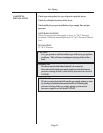
Page 24
Dryer Installation with Multiple Exhaust
For Exhaust Duct more than 14 feet and 2 elbows equivalent and more
than 0.3 inches static pressure.
(See illustration on next page.)
1. Make-up air from outside building may enter enclosure from top or
side walls. Area of opening should be equal to 4 to 6 times the sum of
dryer duct areas. Provide 1 square foot (.1m²) for each 6 inches (15.24
cm) diameter; 2 square feet (.2m²) for each 8 inches (20.3 cm)
diameter; and 4 square feet (.4m²) for each 12 inches (30.5 cm)
diameter.
2. Use constant diameter duct with area equal to the sum of dryer duct
areas.
EXAMPLE: 6-8 inches (20 cm) diameter duct = 1-19.6 inches (49.8
cm) diameter duct in area. Use 20 inches (50 cm) diameter duct or
diameter to match tube-axial fan.
3. Enclosure (plenum) with service door. This separates the dryer air from
room comfort air. If dryers use room air instead of outside air, the heat
loss can be another 25 BTU/HR (6.3 kcal/hr) for each cubic foot per
minute (CFM) used.
4. Zero inches clearance to combustible material allowed on sides and at
points within 4 inches (100 mm) of front on top.
5. Heat loss into laundry room from dryer fronts only is about 60 BTU/
HR per square foot (15 kcal/hr per 0.1m²).
6. Flange mounted, belt driven tube-axial fan. Fan must run when one or
more dryers are running. See suggested Automatic Electrical
Control Wiring Diagram on previous page. Must meet local
electrical codes. Fan air flow (CFM) (M³/min.) is equal to sum of dryer
air flows, but static pressure (SP) is dependent on length of pipe and
number of elbows.
7. Barometric Bypass Damper—Adjust to closed flutter position with
all dryers and exhaust fan running. Must be located within enclosure.
CAUTION: Never install hot water heaters or other gas appliances
in the same room as dryers. Never install cooling exhaust fans in the
same room as dryers.
CAUTION: Never exhaust dryers with other types of equipment.
DRYER INSTALLATION
WITH MULTIPLE EXHAUST


















